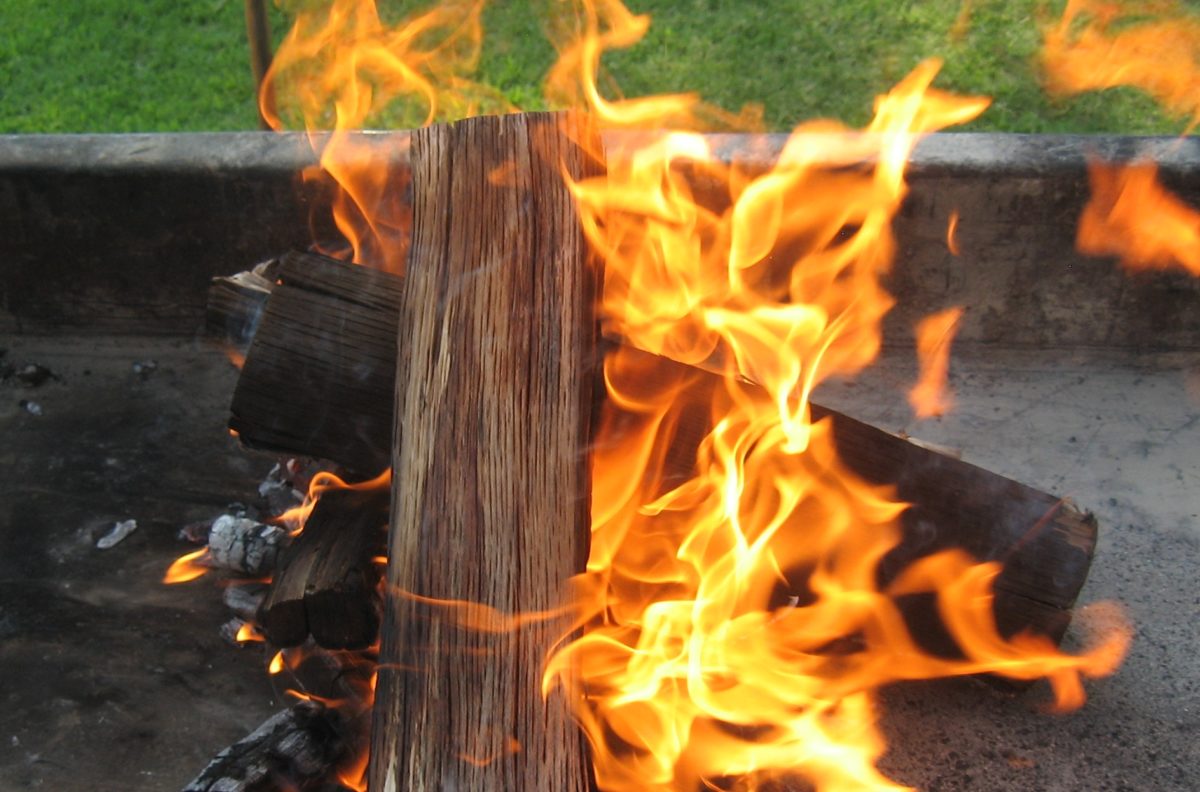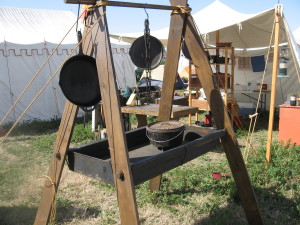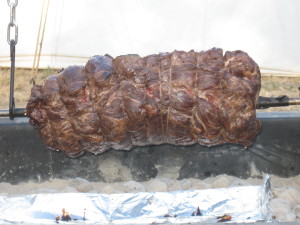I admit it. I have a passion for period cooking. I love cooking with fire and I find eating period foods cooked in a period manner enhances the experience of camping at SCA events. I also realize not everyone shares my passion. But, I refuse to accept that I cannot change their minds.
Our camp gets a lot of attention. We have won “Best Period Encampment” so many times it is a bit embarrassing. We have had numerous “tours” come through our camp at Great Western War, and we even had a film crew capture one of our bread baking days. I realize most of the attention we receive is because of the awesome Viking Brazier we have,
… shown here on it’s Maiden Voyage at Estrella War in 2010. It works very well for our camp, as we usually are cooking for at least a dozen folks, and we have quite a few cooks in our camp. We can do many thing at once on this brazier. But, there are many other options available for cooking with fire in camp; we have done all of them — and still do! — from time to time.
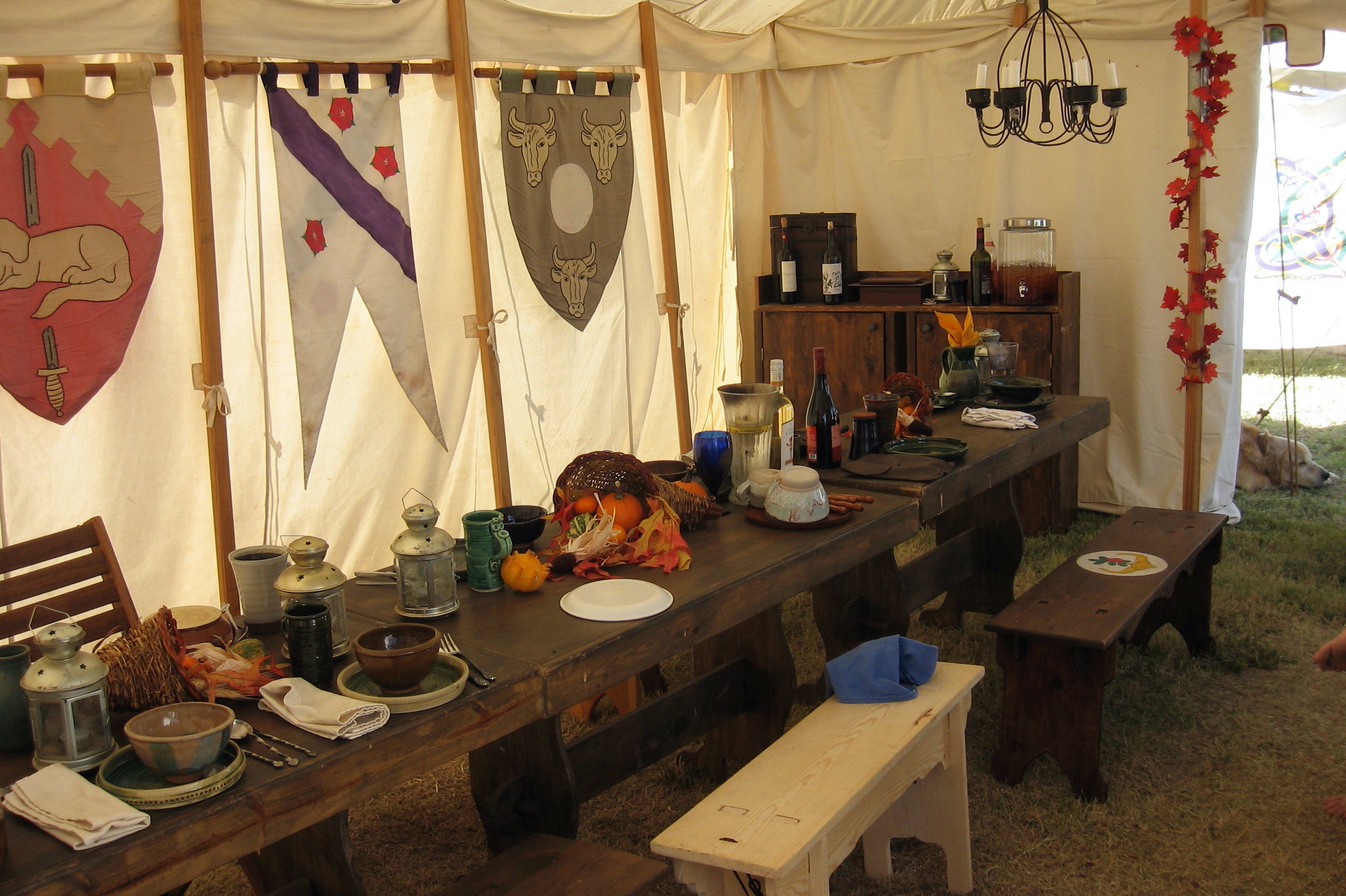 It is not necessary to know period recipes to enjoy the magic that period cooking brings to any encampment. My husband and I taught a class at Great Western War in 2012 that I hope took a lot of the fear and mystery out of cooking with fire, as we demonstrated period cooking methods that could be utilized in any camp. As it was the household’s feast night, we had an extensive menu to demo using a variety of cooking techniques.
It is not necessary to know period recipes to enjoy the magic that period cooking brings to any encampment. My husband and I taught a class at Great Western War in 2012 that I hope took a lot of the fear and mystery out of cooking with fire, as we demonstrated period cooking methods that could be utilized in any camp. As it was the household’s feast night, we had an extensive menu to demo using a variety of cooking techniques.
The Menu:
oatmeal leek soup
beef loin with Lamprey sauce
roast chicken
pork sausage & sauerkraut
honey glazed squash
fresh bread
apples with oat crumble
The oatmeal leek soup was hung in a cauldron over a simple fire pit, where the chicken had been earlier — before it was removed to lie in sauce in a Dutch oven until service. A small Dutch oven table was lined with fire brick, and the bread baked there, under a ceramic flowerpot. The Viking brazier held the re-located Dutch ovens (since their table was occupied) containing the chicken, the pork & sauerkraut and the apples & oats, and the beef loin was being turned on a spit on the other side of the brazier.
One of the hardest adjustments people have to make to period camp cooking is the modern notion of “fresh off the grill” — the idea that WE wait for food. This is just not true of most medieval cooking. The best medieval dishes wait for US. Many, many things — like savory pies and tarts, for example — actually taste better once they are allowed to cool to room temperature. Others, roasted meats, especially, are meant to be rested after roasting, sliced, and returned to their collected juices (or sauce) before serving. We used two such recipes for this class, included below:
Loin of Beef With Lamprey Sauce.
[Du Fait de Cuisine, Master Chiquart Amiczo, 15th c France]
Roast the meat on a spit until almost done. Remove it from the fire, allow to rest and then carve it into serving pieces. Set aside to keep warm. Place two slice of toasted bread in a large saucepan. Cover with red wine, beef stock and a small amount of red wine vinegar. Cook over medium heat, stirring to break the bread and blend ingredients. Bring to a boil, then simmer for 5 minutes. Add poudre forte and a bit more vinegar. Reduce to desired consistency. Add the meat and allow the flavors to marry. Serve the meat and any additional sauce on top.
Roast Chicken. [Platina book 6]
You will roast a chicken after it has been well plucked, cleaned and washed; and after roasting it, put it into a dish before it cools off and pour over it either orange juice or verjuice with rosewater, sugar and well-ground cinnamon, and serve it to your guests.
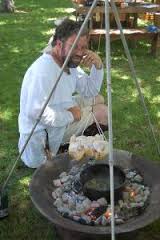 Our favorite way of roasting chickens is demonstrated, here, by Baron Jon Thomme de Clayton, as he prepared it as a part of the winning cooking team of Cast Iron Chef Lyondemere, in 2011.
Our favorite way of roasting chickens is demonstrated, here, by Baron Jon Thomme de Clayton, as he prepared it as a part of the winning cooking team of Cast Iron Chef Lyondemere, in 2011.
This is great fun! The chickens are spatchcocked (the backbone is removed so the chicken can lie flat), skewered and hung beside a hot fire. The chicken will spin one way and then the other, allowing for an even cooking. The chicken can then be flipped, for cooking on the other side.
<><><>
Fire is our Friend! But, it can also be our Worst Enemy if we do not follow safety rules!
SAFETY, SAFETY, SAFETY!
- Observe site fire rules & display fire extinguishers in clear site.
- Protect the space above, below and around your fire.
- Keep tools in the same place every time, so they can be located in the dark.
- Do not put tools on the ground.
- NO CLOAKS OR LOOSE SLEEVES AROUND THE FIRE.
- Cook on coals, not over flames.
- Cook meat NEXT TO the fire, not above it.
- Cooking vessels should be heated slowly and cooled gradually.
- Keep combustible materials away from the fire.
- Leave your lighter fluid at home.
- Have a metal container available to collect ashes, and know where the hot ash trash cans are located on site.
<><><>
“S ann nas fheàrr a bhith fìor ceart ‘sa linn.”

